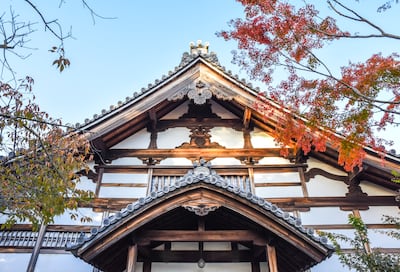He was a peasant who miraculously became a samurai and one of Japan's greatest leaders, and eventually reunified his strife-torn country in the 1500s. But for Kita-no-Mandokoro, the feared and famed Toyotomi Hideyoshi was simply the love of her life. Someone she missed so dearly that when he died, she dedicated herself to building an extraordinary temple in his honour.
Most of the travellers that visit Kodai-ji Temple are probably unaware that, just like India's famed Taj Mahal, this Buddhist masterpiece is a symbol of everlasting love.
Scroll through the gallery above for more pictures of the Kodai-ji Temple
The Taj Mahal is admired not only for its majestic architecture — the white marble mausoleum is also revered for its romantic back story. It was built almost 400 years ago by Mughal emperor Shah Jahan as a magnificent tomb for Mumtaz Mahal, his adored wife of nearly two decades, who died during childbirth.
On her deathbed, the emperor promised his wife she would have the most lavish resting place the world had witnessed. He was true to his word.

Similarly spectacular, yet not nearly as famous, is the Kyoto temple erected as a memorial to Hideyoshi by his wife. I was unfamiliar with their tale of eternal devotion until I entered this sprawling Buddhist complex.
Kodai-ji temple commands an attractive location at the foot of the Higashiyama Ryozen mountains. It is one of many Buddhist temples and Shinto shrines in Higashiyama, Kyoto’s charming old town. This is among the most authentic ancient neighbourhoods in all of Japan, full of narrow streets lined with historic wooden buildings and traversed by the city’s famed geishas. Many female tourists to Kyoto dress up as these snowy-faced entertainers while exploring Higashiyama.
I came across such a group on the stunning grounds of Kodai-ji. This sequence of 17th-century prayer halls, pavilions and bridges is carefully arranged among the natural splendour of forests, ponds and bamboo groves. It is particularly striking in November when Japan’s autumnal bloom bathes the temple in a palette of warm colours. As befitting its standing as a monument of love, Kodai-ji’s many scenic nooks are popular backdrops for cuddling couples, posing families and wedding shoots.
While waiting my turn to photograph a particularly appealing spot, I read about Kodai-ji’s history. It centres on the monumental figure of Hideyoshi, who was born into a working-class family in 1536, during a long passage of bloody turbulence in Japan known as the Warring States period.
This era was triggered by the Onin War of 1467 to 1477, during which the country’s military government lost its authority. Into this power vacuum stepped many warlords who fought over territory for more than a century thereafter. Rather than accept his marginal place in Japanese society, Hideyoshi aimed high. At a young age, he left home to become a soldier and, eventually, ascended to the rank of samurai.
Gradually, he gained allies and leverage until he became one of the country’s most powerful warlords, feared from north to south. He led his armies from behind the lofty walls of what are now two of Japan’s biggest tourist attractions, Osaka Castle and Himeji Castle.
It was from within the former monumental complex that Hideyoshi and two other warlords finally reunited Japan. Together, they formed the Tokugawa shogunate. This military government ended the Warring States period and then controlled Japan in relative peace for more than 250 years.
Hideyoshi’s image now adorns many public spaces across the country. That includes the interior of Kodai-ji Temple, where he is pictured alongside the woman who built this gorgeous setting in his memory. Kita-no-Mandokoro, also known as Nene, was at Hideyoshi’s side for the final 37 years of his life.

When they married, in 1561, Hideyoshi was only a low-level soldier. Nene did not become a trophy partner or a housewife. Instead, she rose alongside her ambitious and ruthless husband, becoming an influential figure in his clan. He reportedly showed her great respect and leaned on her judgment, even in military matters.
In this way, they became one of the first power couples in Japanese history, him leading their charges into battle and her strategising from within their many castles. This made their relationship unique during an era in Japan when wives typically were very subordinate to their husbands.
It should be said, though, their marriage was far from a fairy tale and the couple were often separated by distance. But their unusually deep bond persisted even after his death in 1598. And now, it is embodied by Kodai-ji.
This complex manages to encapsulate many of the joys of Kyoto, Japan’s most traditional city. Kyoto is renowned for its religious sites, classical gardens, verdant forests and magnificent bamboo groves, all of which feature inside the ornate stone walls of Kodai-ji.

When she had it built in the early 1600s, Nene wanted this temple to be a site of serenity and contemplation, somewhere she could wander alone while remembering her late husband. I found it to be a remarkably peaceful place. In the late afternoon, as sun rays filtered through the thousands of stalks in its bamboo grove, I put down my camera for a few minutes and soaked in the gentle light and lulling atmosphere.
Equally majestic is the nearby temple garden, which I discovered is laden with maple trees, their leaves ranging from gold to orange, pink and red. It is flanked by Houjyo, the main prayer hall, which is embellished by gilded designs, and a sparse but attractive stone garden.
Beyond that is Otama-ya, the hall that commemorates Hideyoshi and Nene. At its centre is a gold-and-silver thread coat once worn by Hideyoshi. He donned such garments over his armour during the battles that preceded his successful reunification of Japan. When he returned from the front lines, a special woman was waiting for him. An ally and a confidante, Nene honoured her husband in life and, by building Kodai-ji, celebrated their love in perpetuity.








